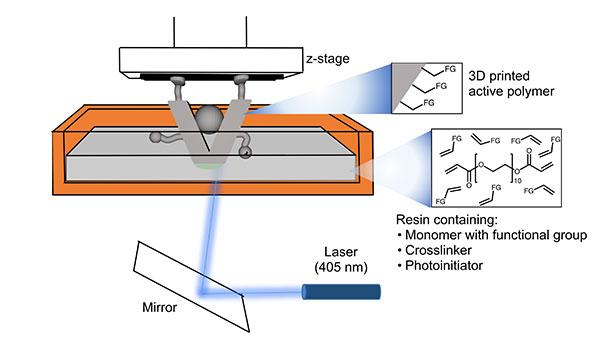
One-Step 3D Laser Printing of Catalysts
source:Photonics
release:Nick
keywords:3Dprinting;Laser3DPrinting;Additivemanufacturing
Time:2017-11-03
AMES, Iowa, Nov. 2, 2017 — A 3D laser printing process that creates a chemically active catalytic object in a single step has opened the door to more efficient ways to produce catalysts for complex chemical reactions in a wide scope of industries.

Catalysts can be built in one step by directly shining a laser through a bath of customized resins that polymerize and harden layer by layer. Courtesy of Ames Laboratory, U.S. Department of Energy.
While 3D printing has found applications in many areas, its use as a way to co ntrol chemical reactions, or catalysis, is relatively new. Current production of 3D catalysts typically involves various methods of depositing the chemically active agents o nto preprinted structures.
The U.S. Department of Energy's Ames Laboratory method combines the structure with the chemistry in o nly one step using inexpensive commercial 3D printers. The structures are designed in a computer and built directly by shining a laser through a bath of customized resins that polymerize and harden layer by layer. The final product that emerges has catalytic properties already intrinsic to the object.
"The monomers, or building blocks that we start with, are designed to be bifunctional. They react with light to harden into the three-dimensio nal structure, and still retain active sites for chemical reactions to occur," said Sebastián Manzano, a graduate student in the Department of Chemistry at Iowa State.
The catalysts built with the Ames Laboratory method demo nstrated success in several reactions common to organic chemistry. They are also adaptable with further post-processing, making possible multistep reactions.

Ames Laboratory has developed a one-step 3D-printing process for catalysts that can be customized to any shape — in this demonstration, the Ames Laboratory logo design. Courtesy of Ames Laboratory, U.S. Department of Energy
"We can co ntrol the shape of the structure itself — what we call the macroscale features — and the design of the catalyst — the nanoscale features — at the same time," said Igor Slowing, a scientist in heterogeneous catalysis at the U.S. Department of Energy's Ames Laboratory. "This opens up many possibilities to rapidly produce structures custom designed to perform a variety of chemical conversions."

Catalysts can be built in one step by directly shining a laser through a bath of customized resins that polymerize and harden layer by layer. Courtesy of Ames Laboratory, U.S. Department of Energy.
While 3D printing has found applications in many areas, its use as a way to co ntrol chemical reactions, or catalysis, is relatively new. Current production of 3D catalysts typically involves various methods of depositing the chemically active agents o nto preprinted structures.
The U.S. Department of Energy's Ames Laboratory method combines the structure with the chemistry in o nly one step using inexpensive commercial 3D printers. The structures are designed in a computer and built directly by shining a laser through a bath of customized resins that polymerize and harden layer by layer. The final product that emerges has catalytic properties already intrinsic to the object.
"The monomers, or building blocks that we start with, are designed to be bifunctional. They react with light to harden into the three-dimensio nal structure, and still retain active sites for chemical reactions to occur," said Sebastián Manzano, a graduate student in the Department of Chemistry at Iowa State.
The catalysts built with the Ames Laboratory method demo nstrated success in several reactions common to organic chemistry. They are also adaptable with further post-processing, making possible multistep reactions.

Ames Laboratory has developed a one-step 3D-printing process for catalysts that can be customized to any shape — in this demonstration, the Ames Laboratory logo design. Courtesy of Ames Laboratory, U.S. Department of Energy
"We can co ntrol the shape of the structure itself — what we call the macroscale features — and the design of the catalyst — the nanoscale features — at the same time," said Igor Slowing, a scientist in heterogeneous catalysis at the U.S. Department of Energy's Ames Laboratory. "This opens up many possibilities to rapidly produce structures custom designed to perform a variety of chemical conversions."
MOST READ
- RoboSense is to Produce the First Chinese Multi-beam LiDAR
- China is to Accelerate the Development of Laser Hardening Application
- Han’s Laser Buys Canadian Fiber Specialist CorActive
- SPI Lasers continues it expansion in China, appointing a dedicated Sales Director
- Laser Coating Removal Robot for Aircraft
PRODUCTS
 FISBA exhibits Customized Solutions for Minimally Invasive Medical Endoscopic Devices at COMPAMED in
FISBA exhibits Customized Solutions for Minimally Invasive Medical Endoscopic Devices at COMPAMED in New Active Alignment System for the Coupling of Photonic Structures to Fiber Arrays
New Active Alignment System for the Coupling of Photonic Structures to Fiber Arrays A new industrial compression module by Amplitude
A new industrial compression module by Amplitude Menhir Photonics Introduces the MENHIR-1550 The Industry's First Turnkey Femtosecond Laser of
Menhir Photonics Introduces the MENHIR-1550 The Industry's First Turnkey Femtosecond Laser of Shenzhen DNE Laser introduced new generation D-FAST cutting machine (12000 W)
more>>
Shenzhen DNE Laser introduced new generation D-FAST cutting machine (12000 W)
more>>





